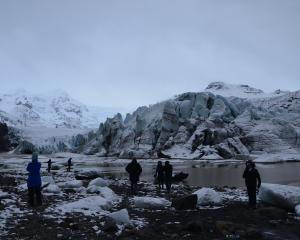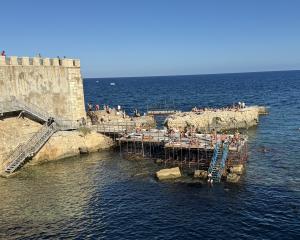Here's why.
The capital city, Asuncion, has an airport not unlike Dunedin's, minus the cold and silage aroma outside.
But go to the downtown bus terminal and you're in another world.
This is where it all happens; the ticket deals, the money-changing, the buying and selling of everything under the sun from knickers to footballs, lipstick to shoes, DVDs to coat hangers.
Local produce is for sale at crazy low prices, from papayas to bananas to oranges, neatly peeled with the top sliced off, and freshly squeezed juice.
For almost nothing you can sample the hot, just-baked chipas (crunchy, salty Paraguayan bread).
Or just sit down at one of the many stalls and try some terere, the Paraguayans' preferred form of tea, served ice-cold and sipped through a metal straw - the perfect way to stave off thirst in the still-warm winter months.
Once you're on the bus it's not all five-star comfort.
We were told some have air-conditioning and movies, but, though we dutifully attempted to get tickets from the recommended company (called Nuestra Senora de la Asuncion), somehow, when the bus arrived, it was always the other one - the one that stopped in every town and village along the way.
It's a safe bet to add two hours to the travel time quoted to cover these stops.
OK, it might be hot and the air-conditioning might consist of an open window if you're lucky.
I found hair ties useful to pin the curtains out of my face and noticed that more often than not the seats were detached from the bit beneath.
In the absence of a functioning postal service, the buses in Paraguay are more than buses.
On one trip our driver picked up a parcel and dropped it off, delivered cheese, picked up letters and documents, and picked up some urine samples for delivery at the hospital.
I had concerns about the usefulness of the urine sample - it was promptly put into the sun on the dashboard.
The driver also assisted with unco-operative luggage, like the chook that poked its head out of a yellow bag belonging to a woman with teased hair and matching yellow dress.
All the way the driver and his partner shared terere from a cold thermos and kept up a jovial, but to us, incomprehensible banter.
Guarani, the indigenous language, has been incorporated into the local Spanish dialect.
Imagine Spanish with the consonants slurred, or missing altogether, and key nouns changed and you get the idea.
An example is the word "Bogado": Paraguayans don't bother with either the g or the d.
Stops are not only for passengers; roadside cafes are visited regularly to replenish the ice water, served by beautiful young women, of whom Paraguay seems to have an abundance.
The drivers help old people on and off, and watch that the gringos don't get lost - we missed our stop once, were ushered to the front until a bus was hailed going in the other direction, then shooed across the road on to the returning bus; all done with arm movements and eye contact.
It worked surprisingly well.
The drivers also keep an eye on the small children who travel alone.
I recall a child of about 6 with a pink and green backpack.
Already in her small face was the sharpness of eye and the set of the jaw of an independent person.
She could have been in training.
Bus-driving and ticketing is no longer monopolised by men; on another trip a young woman in a red "woman power" T-shirt nimbly worked the aisle counting money and distributing tickets with the skill of an adept.
One advantage of bus travel is the price.
A ticket to any part of Asuncion on a local bus costs about NZ70c.
You just have to be prepared to hold on and enjoy the ever-colourful scene unfold before you, inside and outside the bus.
A trip from Asuncion to Encarnacion in the southeast, a seven-hour journey, cost us about $23 each, and the ride between Encarnacion and Ciudad del Este on the eastern border, a five-and-a-half-hour journey of 260km, cost $17.
Saturday traffic, we were told.
And I thought Auckland was bad.
The day before had been more successful.
We crossed from Paraguay through Brazil and into Argentina to visit Iguazu Falls, an hour-long trip costing about NZ$2.
This is a secret that even the travel books haven't caught up with: by basing yourself in Ciudad del Este, Paraguay on a trip to Iguazu, you save money and avoid many of the tourist swarms.
Iguazu is a must - everything you expect and more, even for a Kiwi, spoilt as we are by awesome natural beauty.
But, after Paraguay, at Iguazu you are back in the world of the tourist dollar where everything is expensive, clean and working.
However, our return trip to Ciudad del Este was not a normal tourist experience.
Graham Greene take note: smuggling is alive and well in Paraguay 2010.
Our bus smuggled about 240 cans of Budweiser beer, three large suitcases, a large plastic carry bag and two smaller backpacks of brown paper-wrapped goods, all stacked below feet, under seats, and covered in blankets.
There were at least five people in on the operation, but the whole busload - even the gringos - knew more or less what was going on.
The driver was definitely in with a cut.
Things got tense at the Argentina-Brazil border when one of the young women was called back into the customs office.
We waited for five to 10 minutes for her return, while the armed border patrol guards wandered past the bus.
She finally returned and her story, whatever it was, kept passengers and driver amused for the entire return journey.
As we slid across the Parana River Bridge into Paraguay there were whoops and congratulations all round.
Someone jumped off (presumably to get the getaway car) and the others gathered their loot from under legs and seats.
Paraguayan buses may not always be on time but, if you've got time, there's no better way to learn about this country.
In a land where so few hold so much wealth - the landowning 1% travelling within their dark-windowed Mercedes - buses are the pulse and lifeblood for the rest, as they weave their way through the cities, towns and villages of the real Paraguay.
Getting there:
We found the cheapest way to get to Paraguay from New Zealand is via Buenos Aires with Aerolineas Argentinas. Flight time to Buenos Aires is 11.5 hours. Then allow a couple of hours to get from one airport (Pistarini) to another (Aeropaque), and the flight to Asuncion is 1 hour 55 minutes. All up, our return tickets cost about $1600 each, including taxes.
Visa requirements:
Kiwis need a visa to enter Paraguay, which must be obtained from:Consulate General of Paraguay in MelbourneSuite 1, 600 Lonsdale St, Melbourne 3000 Ground FloorTel. +(61-3) 9670-0555 Fax. +(61-3) 9670-4559Melbourne, Australia
Website: www.paraguayconsul.orgYou can get a multiple-entry 90-day visa, which will allow for crossing over to Iguazu. They only accept cash or bank cheques in Australian or US dollars.
• Rosemary Penwarden lives in Waitati.











